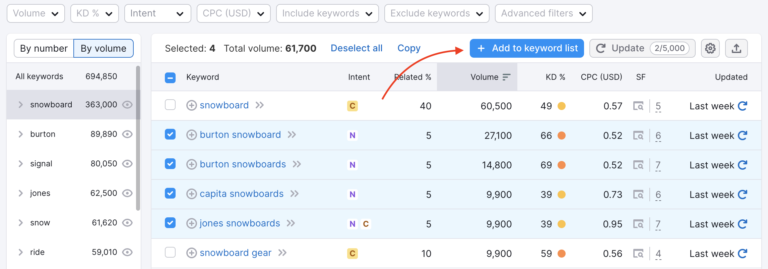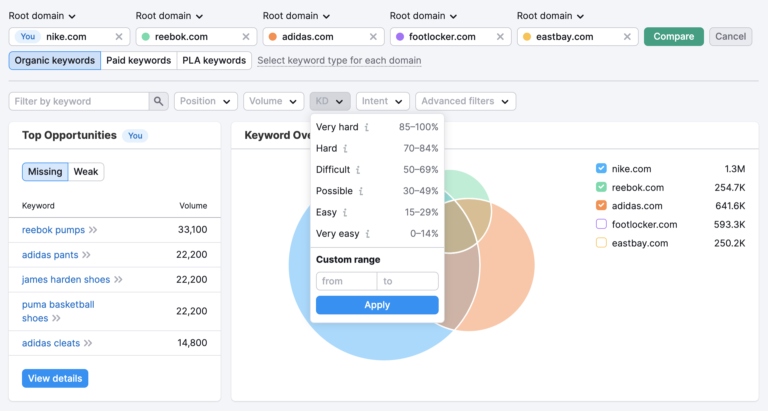Finding the monthly search volume for a keyword is crucial for SEO success. It helps you understand how often people search for specific terms.
Knowing the search volume can guide your content strategy and marketing efforts. This data shows the popularity of keywords, helping you choose the right ones to target. By understanding search volume, you can create content that meets the needs of your audience and ranks higher in search engines. This guide will walk you through the steps to find the monthly search volume for any keyword. We’ll explore easy-to-use tools and methods. Whether you are a beginner or experienced marketer, learning this skill is essential. Let’s dive in and make keyword research simpler for you!

Credit: www.positional.com
Importance Of Keyword Research And Keyword Search Volume
Introduction paragraph about How to Find a Monthly Search Volume for a Keyword and Importance of Keyword Research and keyword search volume. Understanding the monthly search volume for a keyword helps you gauge its popularity. This insight is vital for effective keyword research. Knowing which keywords are frequently searched can improve your content strategy. This can, in turn, increase your website’s visibility and traffic.
Boosting Seo
Keyword research and knowing the search volume can significantly boost your SEO. When you know which keywords have a high search volume, you can target them in your content. This makes your site more relevant to what people are searching for. As a result, search engines rank your site higher.
Here are some ways keyword search volume helps in boosting SEO:
- Improves Content Relevance: High search volume keywords align your content with user queries.
- Helps in Competitor Analysis: Knowing which keywords your competitors rank for can give you an edge.
- Increases Organic Traffic: Targeting popular keywords can drive more organic traffic to your site.
- Enhances User Experience: Relevant content improves user engagement and reduces bounce rates.
A table can also be useful to list keywords based on their search volume:
| Keyword | Monthly Search Volume | Competition |
|---|---|---|
| Best SEO practices | 10,000 | High |
| Keyword research tools | 8,000 | Medium |
| Improve website traffic | 5,000 | Low |
Driving Traffic
Knowing the search volume of keywords is crucial for driving traffic to your website. High search volume keywords indicate what users are looking for. By incorporating these keywords into your content, you can attract more visitors.
Consider these benefits:
- Targeted Audience: High search volume keywords help you target the right audience.
- Content Strategy: Knowing popular keywords helps you create content that meets user needs.
- Increased Visibility: Popular keywords can improve your site’s visibility on search engines.
- Higher Click-Through Rates: Relevant keywords can lead to higher click-through rates.
By focusing on high search volume keywords, you can create content that resonates with your audience. This not only drives traffic but also boosts engagement and conversions.
For example, if you run a blog about gardening, targeting keywords like “best gardening tips” or “how to grow tomatoes” can attract more readers. These keywords have high search volumes, indicating a strong interest.
In short, keyword search volume is a powerful tool. It helps you understand user behavior and create content that drives traffic to your site.
Tools For Keyword Volume
Finding a monthly search volume for a keyword is essential for SEO. It helps understand the popularity of a keyword and guides content strategy. Various tools can help find keyword volume. Here, we explore two popular tools: Google Keyword Planner and SEMrush.
Google Keyword Planner
Google Keyword Planner is a free tool by Google Ads. It helps find keyword volumes and trends. To use it, you need a Google Ads account. Once you log in, follow these steps:
- Click on the “Tools & Settings” menu.
- Select “Keyword Planner.”
- Choose “Discover new keywords.”
- Enter a keyword or phrase.
- Click “Get results.”
The tool will show you a table with data. This includes average monthly searches, competition, and bid ranges. Here’s an example:
| Keyword | Avg. Monthly Searches | Competition | Top of Page Bid (low range) | Top of Page Bid (high range) |
|---|---|---|---|---|
| SEO tips | 1,000 – 10,000 | Low | $1.00 | $2.50 |
| Keyword research | 10,000 – 100,000 | Medium | $2.00 | $5.00 |
Pros: It’s free and provides accurate data from Google.
Cons: Data ranges are broad and require a Google Ads account.
Semrush
SEMrush is a comprehensive SEO tool. It offers detailed keyword analysis, including search volumes. Here’s how to use it:
- Log in to your SEMrush account.
- Go to “Keyword Overview.”
- Enter the keyword in the search bar.
- Click “Search.”
SEMrush provides a detailed report. This includes:
- Exact monthly search volume.
- Keyword difficulty score.
- Top-ranking pages for the keyword.
- Related keywords.
Here’s an example table:
| Keyword | Monthly Search Volume | Keyword Difficulty | Top Ranking Page |
|---|---|---|---|
| SEO tools | 22,000 | 70% | example.com/seo-tools |
| Best keywords | 15,000 | 65% | example.com/best-keywords |
Pros: Provides detailed and precise data, user-friendly interface.
Cons: It is a paid tool, which might be expensive for beginners.
Using Google Trends For Search Volume
Introduction paragraph about How to Find a Monthly Search Volume for a Keyword and Using Google Trends for search volume. Google Trends is a powerful tool that helps understand the popularity of search terms over time. By leveraging this tool, you can gain insights into how often a keyword is searched for each month. This can guide your content strategy and ensure you target the right audience.
Analyzing Trends
Google Trends provides a visual representation of keyword popularity over time. To analyze trends, follow these steps:
- Go to the Google Trends website.
- Type your keyword into the search bar.
- Choose the desired time range, such as the past 12 months.
The results will display a graph showing the keyword’s popularity. Peaks on the graph indicate higher search volumes during specific times. Understanding these peaks can help you identify seasonal trends or recurring patterns.
Consider the following table for a clearer understanding:
| Month | Search Volume Index |
|---|---|
| January | 80 |
| February | 85 |
| March | 90 |
The numbers in the table represent the relative search volume index. This index helps compare different months to see how search interest changes. For example, a higher index in March suggests increased interest in that keyword during that month.
Use the insights from this analysis to plan your content calendar. If you see a spike in searches during a specific month, publish related content just before that time to capture the audience’s interest.
Comparing Keywords
Google Trends also allows you to compare multiple keywords. This can help you decide which keyword to focus on. To compare keywords:
- Enter your first keyword in the search bar.
- Click on “Compare” and add additional keywords.
- View the comparative graph that appears.
For example, if you compare “SEO tips” and “content marketing”, the graph will show their relative popularity over time. This visual comparison helps identify the more popular keyword.
Consider the following table for a sample comparison:
| Month | SEO Tips | Content Marketing |
|---|---|---|
| January | 70 | 60 |
| February | 75 | 55 |
| March | 80 | 70 |
The table shows that “SEO tips” had higher search volumes in January and February compared to “content marketing”. This indicates that focusing on “SEO tips” might attract more traffic during those months.
Using these comparisons, you can make informed decisions about your keyword strategy. Choose the keywords with higher search volumes to maximize your reach and engagement.

Credit: backlinko.com
Analyzing Competitor Keywords To Find The Search Volume
To improve your website’s visibility, you need to understand the monthly search volume for keywords. Analyzing competitor keywords can help you find this data. By studying your competitors’ strategies, you can uncover valuable insights about keyword popularity and trends. This approach provides you with an idea of what works in your industry and helps you stay ahead in the game.
How Competitor Keyword Give Us Idea About The Keyword Search Volume
Competitor keywords can reveal the search volume of keywords. By analyzing what keywords your competitors rank for, you can estimate the search volume of those keywords. Competitors often target high-volume keywords to drive traffic. This can give you clues about which keywords are popular.
Here are some steps to analyze competitor keywords:
- Use tools like SEMrush or Ahrefs to find keywords your competitors rank for.
- Check the search volume data provided by these tools.
- Compare the keywords with your own list to find common high-volume keywords.
For example, if a competitor ranks for “best running shoes” and the search volume is high, it’s likely a valuable keyword. You can consider targeting similar keywords to attract more traffic.
Remember, competitor keyword analysis is a continuous process. Keep updating your keyword list based on new data and trends.
Identifying Gaps
Identifying gaps in your keyword strategy is crucial for improving your search volume. By analyzing competitor keywords, you can find keywords they rank for but you don’t. These gaps are opportunities for you to target new keywords and attract more traffic.
Here’s how to identify gaps:
- Create a list of keywords your competitors rank for using tools like SEMrush or Ahrefs.
- Compare this list with your own keyword list.
- Identify keywords that your competitors rank for but you don’t.
For example, if your competitor ranks for “cheap running shoes” and you don’t, this is a gap. You can create content around this keyword to fill the gap.
Use a table to organize your findings:
| Keyword | Competitor Rank | Your Rank | Search Volume |
|---|---|---|---|
| Cheap running shoes | 1 | – | 10,000 |
| Best running shoes | 3 | 5 | 15,000 |
Filling these gaps can help you improve your rankings and attract more traffic.
Leveraging Insights
Leveraging insights from competitor keyword analysis can boost your SEO strategy. Use the data to refine your keyword targeting and content creation. This helps you stay competitive and improve your search volume.
Here are some ways to leverage insights:
- Identify high-volume keywords your competitors rank for and target them.
- Analyze the content your competitors create around these keywords.
- Create better and more comprehensive content to outrank your competitors.
For example, if your competitor’s top keyword is “best running shoes,” analyze their top-ranking content. Create a more detailed and informative article on the same topic. Add unique insights, images, and videos to make your content stand out.
Also, use the insights to improve your on-page SEO. Optimize your title tags, meta descriptions, and headings with high-volume keywords. This can improve your search engine rankings.
Regularly monitor your competitors and update your strategy based on new insights. This helps you stay ahead and attract more traffic.
Long-tail Keywords
Finding the monthly search volume for a keyword is crucial for any SEO strategy. One important aspect to consider is long-tail keywords. Long-tail keywords are phrases that are more specific and usually longer than common keywords. They often have lower search volumes, but they can be highly valuable. They target niche markets, which can lead to higher conversion rates. In this section, we will explore how to find the search volume for long-tail keywords, the benefits of using them, and how to effectively find these keywords.
How To Find Long Tail Keyword Search Volume
Finding the search volume for long-tail keywords can be a bit tricky due to their specific nature. Here are some effective methods:
- Google Keyword Planner: This tool is great for getting an estimate of search volumes. Enter your long-tail keyword and see the average monthly searches.
- Ubersuggest: This free tool provides search volume data along with keyword suggestions. Type in your long-tail keyword to get the data.
- AnswerThePublic: This tool helps identify questions people are asking related to your keyword. It can give insights into long-tail keyword opportunities.
Here is a quick comparison of these tools:
| Tool | Free/Paid | Search Volume Accuracy |
|---|---|---|
| Google Keyword Planner | Free | High |
| Ubersuggest | Free | Moderate |
| AnswerThePublic | Free | Moderate |
Benefits Of Long-tails
Using long-tail keywords can greatly benefit your SEO strategy. Here are some key benefits:
- Lower Competition: Long-tail keywords usually have less competition. This makes it easier to rank higher in search engine results.
- Higher Conversion Rates: These keywords are more specific. Users searching for them are often closer to making a purchase or decision.
- Better Audience Targeting: They help attract a more targeted audience, leading to better user engagement and satisfaction.
Consider this scenario:
| Keyword Type | Example | Search Volume | Competition |
|---|---|---|---|
| Short-Tail | Running Shoes | 50,000 | High |
| Long-Tail | Best Running Shoes for Flat Feet | 1,000 | Low |
Finding Long-tails
Finding long-tail keywords involves a bit of research and creativity. Here are some methods to help you:
- Use Google Autocomplete: Start typing your main keyword into Google. Look at the suggestions that appear. These can be great long-tail keywords.
- Analyze Competitor Websites: Look at your competitors’ content. Identify the long-tail keywords they are targeting.
- Utilize Forums and Q&A Sites: Sites like Quora and Reddit can provide insights into what people are asking about your niche. These questions can be turned into long-tail keywords.
Here are some tools to help you find long-tail keywords:
- KeywordTool.io: Enter your main keyword and get a list of long-tail keyword suggestions.
- SEMrush: Use the keyword magic tool to find long-tail keywords.
- Ahrefs: This tool provides keyword suggestions and search volume data.
By using these methods and tools, you can identify valuable long-tail keywords that will enhance your SEO efforts and attract a more targeted audience.

Credit: www.youtube.com
Interpreting Search Volume Data
Understanding how to find a monthly search volume for a keyword is crucial for effective SEO. Interpreting search volume data helps you make informed decisions about targeting the right keywords. Knowing how to read and use this data can elevate your content strategy and boost your website’s visibility.
Volume Ranges
Search volume ranges give an estimate of how often a keyword is searched within a month. These ranges can be broad or specific, depending on the tool you use. Here are a few points to consider:
- Low Volume (0-100): These keywords have fewer searches but can be less competitive. Ideal for niche topics.
- Medium Volume (100-1,000): These keywords have a moderate search volume. They strike a balance between competition and visibility.
- High Volume (1,000+): These keywords attract a lot of searches. They can be highly competitive.
Using a table can help visualize these ranges more clearly:
| Volume Range | Description |
|---|---|
| 0-100 | Low search volume, less competition |
| 100-1,000 | Medium search volume, moderate competition |
| 1,000+ | High search volume, high competition |
Choosing the right volume range depends on your goals. Low-volume keywords can attract niche audiences. High-volume keywords can bring more traffic but require strong SEO efforts. Medium-volume keywords offer a balanced approach.
Seasonality Effects
Seasonality affects keyword search volumes. Some keywords have higher search volumes during specific times of the year. Understanding these patterns helps you plan your content strategy better:
- Holiday Keywords: Words like “Christmas gifts” or “Halloween costumes” spike during holiday seasons.
- Event-Related Keywords: Keywords like “Olympics schedule” or “Super Bowl ads” peak around major events.
- Seasonal Keywords: Keywords like “summer fashion” or “winter recipes” are popular in their respective seasons.
Here’s a simple table to illustrate seasonality effects:
| Keyword | Peak Season |
|---|---|
| Christmas gifts | December |
| Summer fashion | June – August |
| Halloween costumes | October |
Analyzing seasonality helps you create timely and relevant content. For example, start planning your Christmas content in September to rank higher in December. Use tools like Google Trends to identify these patterns and adjust your content calendar accordingly.
Combining Metrics
Finding the monthly search volume for a keyword involves more than just numbers. Combining metrics helps create a fuller picture of a keyword’s value. This approach includes looking at several key metrics together. Two essential components are search volume and cost-per-click (CPC), and traffic potential. Understanding these metrics can help you make better decisions about which keywords to target.
Search Volume And Cpc
Search volume tells you how often a keyword is searched for in a month. It’s an important metric because it shows demand. A high search volume means many people are interested in that keyword. But, search volume alone is not enough. Cost-per-click (CPC) is another vital metric. CPC shows how much advertisers are willing to pay for a click on their ad for that keyword. A high CPC means the keyword is valuable to businesses.
Here is a table to understand the relationship between search volume and CPC:
| Keyword | Search Volume | CPC |
|---|---|---|
| Keyword A | 10,000 | $5.00 |
| Keyword B | 5,000 | $1.50 |
| Keyword C | 8,000 | $3.00 |
This table shows that even if a keyword has a lower search volume, a high CPC can still make it valuable. For example, Keyword A has a high search volume and CPC. This means it is in high demand and valuable. Keyword B has a lower search volume and CPC, making it less valuable.
Combining search volume and CPC helps you find keywords that are both popular and profitable. This combination gives you a better idea of which keywords to focus on for your content or ads. High search volume means more people are searching for it. High CPC means businesses find it valuable. Together, they help you understand the potential of a keyword.
Traffic Potential
Traffic potential shows how much traffic a keyword can bring to your site. It is different from search volume. Search volume shows how many people search for a keyword. Traffic potential shows how many people visit your site because of that keyword. To find traffic potential, look at the top-ranking pages for that keyword. Tools like Ahrefs or SEMrush can help.
Consider these points to understand traffic potential:
- Top-ranking pages get the most traffic.
- Look at the total traffic these pages get.
- Check if they rank for other related keywords.
This information gives you a better idea of how much traffic you can get. For example, a keyword with a high search volume might not bring much traffic if the top-ranking pages are very strong. But a keyword with a lower search volume might bring more traffic if the competition is weak.
Here is a simple way to calculate traffic potential:
- Find the search volume for the keyword.
- Check the click-through rate (CTR) for the top-ranking pages.
- Multiply the search volume by the CTR.
This formula gives you an estimate of the traffic potential:
Combining metrics like search volume, CPC, and traffic potential helps you choose the best keywords. It gives you a complete picture. You can see the demand, the value, and the traffic potential. This approach helps you make better decisions and get more out of your keyword research.
Staying Updated
In the fast-paced world of SEO, keeping your keyword strategy up-to-date is crucial. Knowing the monthly search volume for keywords helps you stay competitive. This section focuses on the importance of staying updated, ensuring your SEO efforts yield the best results.
Regular Audits
Regular audits of your keywords are essential. Search behaviors and trends change over time. A keyword that was popular six months ago might not be relevant today. Conducting regular audits helps you stay informed about these changes.
Here are some steps for an effective keyword audit:
- Gather all your current keywords.
- Use tools like Google Keyword Planner or Ahrefs to check their current search volumes.
- Identify keywords with declining search volumes.
- Look for new, trending keywords in your industry.
Updating your keyword list based on these audits ensures you are targeting relevant terms. This keeps your content aligned with what users are searching for.
A simple table can help organize your findings:
| Keyword | Previous Search Volume | Current Search Volume | Trend |
|---|---|---|---|
| Keyword A | 1,000 | 800 | Declining |
| Keyword B | 500 | 1,200 | Rising |
Conducting these audits quarterly is a good practice. It ensures your SEO strategy stays fresh and effective.
Adapting Strategies
Adapt your SEO strategies based on your audit results. This means more than just updating keywords. It involves changing your content approach, link-building methods, and even technical SEO aspects.
Consider these steps to adapt your strategies:
- Analyze why certain keywords are declining. Is there less interest in the topic, or are competitors outperforming you?
- For rising keywords, create new content or update existing content to target these terms.
- Check your competitors’ strategies. See which keywords they rank for and how you can improve your content to compete.
- Update your meta tags, headers, and internal links to reflect your new keyword priorities.
Adapting your strategies can also involve technical changes. For instance, improving your site’s load speed or optimizing for mobile can boost your search rankings.
Remember, SEO is not a one-time task. It requires continuous effort and adaptation. By staying updated and flexible, your SEO efforts will be more effective and yield better results.
Frequently Asked Questions
What Is Monthly Search Volume?
Monthly search volume refers to the average number of times a keyword is searched in a month. It helps in understanding keyword popularity and search trends.
How To Check Keyword Search Volume?
You can check keyword search volume using tools like Google Keyword Planner, Ahrefs, or SEMrush. These tools provide accurate data and insights.
Why Is Search Volume Important?
Search volume is important because it helps you understand keyword popularity. It guides your content strategy and SEO efforts to target high-traffic keywords.
Which Tools Are Best For Search Volume?
Some of the best tools for checking search volume are Google Keyword Planner, Ahrefs, SEMrush, and Moz. They provide accurate and comprehensive data.
Conclusion
Finding monthly search volume for a keyword is crucial. It helps target the right audience. Use tools like Google Keyword Planner. Analyze data to refine your strategy. Simple steps can boost your SEO efforts. Stay consistent and keep checking trends.
Your content will improve over time. Happy keyword researching!





